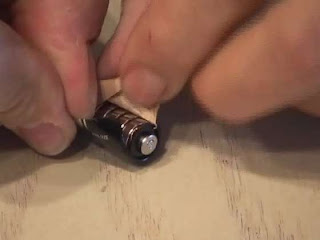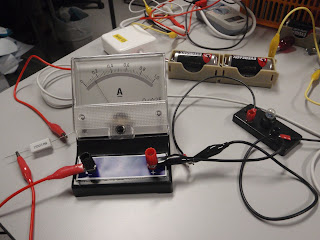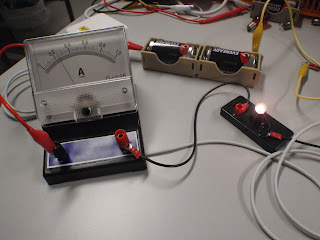In today's lesson, there were some discussion about the various models of electricity.
(a) The conventional current model.
(b) The electron current model.
(c) Rueven's model of displacement.
(d) Mr Tan's model of EM radiation.
Dear students, it is quite obvious that the models (a) and (b) are well established models since Primary School.
However, models (a) and (b) does not seem to explain the electrical circuit effectively.
Then Rueven came to the rescue by introducing the concept that there are already alot of electrons present in the circuit. The battery acts like an energy source that moves a 'chain' of electrons or positive charges around the circuit.
However, Mr Tan questioned that if the wires are very long, will there be a time delay in the circuit? This poses a problem for Rueven's model because that will predict that there is a time delay before the lighting up of the circuit.
For your thinking caps.
2011 S2-04 Science Blog
Tuesday, September 27, 2011
Thursday, September 15, 2011
Monday, September 5, 2011
Brightness
When 2 battery is connected in series with a light bulb, the brightness of the bulb is as follows:
When a similar light bulb is connected in series, the brightness changes to the following:
What happens if the same light bulb is connected in parallel to the existing light bulb instead?
PREDICT and EXPLAIN !
When 2 similar additional batteries are connected in parallel to the existing batteries, the brightness is as follows:
What happens if the 2 similar additional batteries is added in series to the original batteries instead?
PREDICT and EXPLAIN !
Friday, September 2, 2011
Parallel connections (Electricity WS page 13)
(a) Set up a single bulb circuit as shown below:
(i) Connect two bulbs in series and add this combination as a branch in parallel with the single bulb circuit as shown below.(ii) Is there a change in brightness of the single bulb when the second branch is connected?
Resistance (Electricity WS page 10)
Experiment - determine the resistance of a light bulb
Circuit Diagram
How is the resistance of the light bulb calculated ?
From the graph, it is obvious that there are 2 clear sections of graphs.
Explain why are there 2 clear sections.
The resistance of the light bulb can be determined by finding
the gradient of the graph for the first section (dim).
However, the resistance CANNOT be calculated by finding
the gradient for the second section (bright). Explain why.
Tuesday, August 30, 2011
What is inside a 12 volt battery ?
What is inside a D size RECHARGABLE battery ?
http://www.slashgear.com/energizer-d-rechargeable-battery-cracked-open-cheaper-low-power-aa-lurks-inside-2753991/
http://www.abundantlifeessentials.com/news/batteryscam.htm
What is inside a 6 volt battery ?
http://www.metacafe.com/watch/824477/6_volt_battery_hack_youll_be_amazed/
http://www.wisebread.com/revenge-of-the-battery-hack-32-aas-inside-a-6v-lantern-battery-but-is-it-phoney
http://www.youtube.com/watch?v=1D87wnoK-xY
http://www.hoax-slayer.com/6-volt-battery-hack.shtml
http://www.wisebread.com/revenge-of-the-battery-hack-32-aas-inside-a-6v-lantern-battery-but-is-it-phoney
http://www.youtube.com/watch?v=1D87wnoK-xY
http://www.hoax-slayer.com/6-volt-battery-hack.shtml
Batteries come in AAA, AA, C and D sizes. Why not B?
What is in a 9 volt battery ?
What is a variable resistor or Rheostat ?
Saturday, August 27, 2011
How to measure the resistance of a light bulb using an Ohmmeter ?
The resistance of the light bulb measured using this method is 2.6 ohms BUT
the resistance measured using the previous method with the lightbulb lighted up is 10 ohms.
Why is it so ?
Ammeter and Voltmeter
Subscribe to:
Posts (Atom)


















































